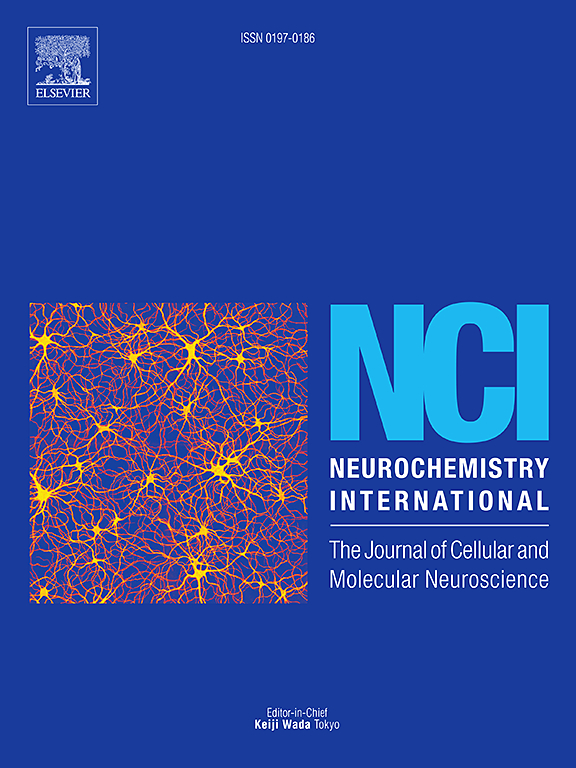纤维蛋白-5对小鼠蛛网膜下腔出血后早期脑损伤的影响
IF 4
3区 医学
Q2 BIOCHEMISTRY & MOLECULAR BIOLOGY
引用次数: 0
摘要
早期脑损伤(EBI)是决定动脉瘤性蛛网膜下腔出血(SAH)预后的重要原因。我们最近的临床研究报告了高浓度的血浆纤维蛋白-5 (FBLN5),一种基质细胞蛋白,与SAH后的不良预后相关。本研究的目的是研究FBLN5是否以及如何与小鼠SAH急性期的EBI相关。C57BL/6雄性小鼠采用假性或细丝穿孔SAH模型,随机给药或4个剂量(0.001、0.01、0.1、1 μg)的短或长重组FBLN5 (rFBLN5)脑室内注射。采用神经行为学测试、脑含水量测定、免疫组织化学染色和Western blotting评估SAH后24小时的EBI。短rFBLN5对EBI无显著影响,但含有精氨酸-甘氨酸-天冬氨酸基元的长rFBLN5可根据剂量改善神经行为功能,而不影响脑水肿。长rFBLN5也减少了裂解型caspase-3依赖性神经元的凋亡,这与sah后转化生长因子-β1上调的抑制有关,但Smad 2/3、丝裂原活化蛋白激酶和另一种基质细胞蛋白tenascin-C的表达水平没有显著变化。虽然还需要进一步的研究来阐明具体的机制,但本研究首次证明了FBLN5在实验性SAH急性期对神经元凋亡具有保护作用。本文章由计算机程序翻译,如有差异,请以英文原文为准。

The effect of Fibulin-5 on early brain injury after subarachnoid hemorrhage in mice
Early brain injury (EBI) is an important cause that determines outcomes after aneurysmal subarachnoid hemorrhage (SAH). Our recent clinical study reported that a high concentration of plasma fibulin-5 (FBLN5), one of matricellular proteins, was associated with poor outcomes after SAH. The aim of this study was to investigate whether and how FBLN5 was associated with EBI during an acute phase of SAH in mice. C57BL/6 male mice underwent sham or filament perforation SAH modeling, and vehicle or four dosages (0.001, 0.01, 0.1, and 1 μg) of short or long recombinant FBLN5 (rFBLN5) were randomly administrated by an intracerebroventricular injection. Neurobehavioral test, measurements of brain water content, immunohistochemical staining, and Western blotting were performed to evaluate EBI 24 h after SAH. Short rFBLN5 had no significant effects on EBI, but administration of long rFBLN5 containing an arginine-glycine-aspartic acid motif improved neurobehavior functions depending on the dosages, without affecting brain edema. Administration of long rFBLN5 also reduced cleaved caspase-3-dependent neuronal apoptosis, associated with the inhibition of post-SAH upregulation of transforming growth factor-β1, but no significant changes in the expression level of Smad 2/3, mitogen-activated protein kinases, and another matricellular protein tenascin-C. Although further research is required to clarify the detailed mechanism, this study demonstrated for the first time that FBLN5 played a protective role against neuronal apoptosis in an acute phase of experimental SAH.
求助全文
通过发布文献求助,成功后即可免费获取论文全文。
去求助
来源期刊

Neurochemistry international
医学-神经科学
CiteScore
8.40
自引率
2.40%
发文量
128
审稿时长
37 days
期刊介绍:
Neurochemistry International is devoted to the rapid publication of outstanding original articles and timely reviews in neurochemistry. Manuscripts on a broad range of topics will be considered, including molecular and cellular neurochemistry, neuropharmacology and genetic aspects of CNS function, neuroimmunology, metabolism as well as the neurochemistry of neurological and psychiatric disorders of the CNS.
 求助内容:
求助内容: 应助结果提醒方式:
应助结果提醒方式:


